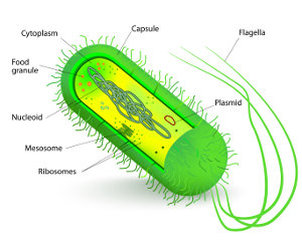 The "Simple" Prokaryote single Cell with over 4 million DNA code bits.
The "Simple" Prokaryote single Cell with over 4 million DNA code bits.
The Question of Complexity - The End of Evolution
First life and complexity of the Cell
In the story of life's origin, naturalists tell us various chemicals collected in ponds and self-assembled into amino acids. (The building blocks of proteins or cell material). In time these acids further self-assembled into proteins, then cells - they say. Now think about this, the leap from an element to protein, then protein to cell is quite a task in itself. This is no different than saying we have aluminum, copper and steel etc., and sprang forth a 747! That’s a small statement about a very big thing when speaking of life coming from chemistry! Evolutionists assert the Prokaryote cell on the right did so. Fact is, this creature has the same number of working parts as the jetliner! One of the proponents of this theory was Dr. Dean Kenyon, outlined in his popular book, Biochemical Predestination. In It, Dr. Kenyon asserted that the valences of chemical compounds could have self-attracted into organized structures ending in a cell. This concept seemed to have saved the idea of mindless self-assembly as required by evolution, but was later disproved.
It should be noted that Kenyon abandoned his theory and later became a strong promoter of Intelligent Design. He determined that if evolution was true it required DNA evolving in parallel synchronization with cell operation, an impossibility without intelligence. Below this excellent video demonstrates the complexity of cell formation and includes live comments by Dr. Kenyon.
Video (5 minutes) -
▶ Unlocking the Mystery of Life (Chapter 10 of 12) - YouTube
First life and complexity of the Cell
In the story of life's origin, naturalists tell us various chemicals collected in ponds and self-assembled into amino acids. (The building blocks of proteins or cell material). In time these acids further self-assembled into proteins, then cells - they say. Now think about this, the leap from an element to protein, then protein to cell is quite a task in itself. This is no different than saying we have aluminum, copper and steel etc., and sprang forth a 747! That’s a small statement about a very big thing when speaking of life coming from chemistry! Evolutionists assert the Prokaryote cell on the right did so. Fact is, this creature has the same number of working parts as the jetliner! One of the proponents of this theory was Dr. Dean Kenyon, outlined in his popular book, Biochemical Predestination. In It, Dr. Kenyon asserted that the valences of chemical compounds could have self-attracted into organized structures ending in a cell. This concept seemed to have saved the idea of mindless self-assembly as required by evolution, but was later disproved.
It should be noted that Kenyon abandoned his theory and later became a strong promoter of Intelligent Design. He determined that if evolution was true it required DNA evolving in parallel synchronization with cell operation, an impossibility without intelligence. Below this excellent video demonstrates the complexity of cell formation and includes live comments by Dr. Kenyon.
Video (5 minutes) -
▶ Unlocking the Mystery of Life (Chapter 10 of 12) - YouTube
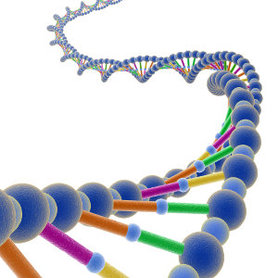 DNA, the most efficient data storage system in the world!
DNA, the most efficient data storage system in the world!
The finding of immense complexity -
The DNA sequence strand, with it's coding equivalent of over 2 GigaBit of data in humans!
When more powerful microscopes became available in the 1960's, an amazing finding was made; the discovery of the DNA coding strand by Dr. Francis Crick. (1) This strand of highly organized chemical units contained the coded technical instructions to build life on a chemical tape, directing the operation and work of the cell. This finding revolutionized man's understanding of life's complexity. The DNA triple base "life code" uses the same language in all living things, from amoeba to man, and is seen to be exactly the same since life first formed. This stasis of the code and mechanism is a challenge to the concept of evolution, a theory that tout's the ability to change life forms quite prolifically! One should consider the contradiction of absolute stasis in cell operation compared the suggested amazing power of evolution, which claims that from a single cell all life forms on Earth were derived. Does DNA (2) point to a common Super-Intelligence or better support the accidental probability of evolution? Evolutions operation depends completely on mutations, or random mistakes entering the genes, causing change. After these changes occur either good or bad, natural selection isolates the good traits and the life form moves forward. If this is true the DNA and cell mechanism should have changed along with it, it has not. This means that the codes for all the different life forms on earth were introduced at some critical point in the past. Biologists often refer to this as the Cambrian explosion. If we open the Bible it would be defined as Creation. The worst diseases doctors treat today are caused by genetic mutations. Nearly 4,000 diseases are caused by mutations in DNA. (4) So in truth, mutations are a poor way to create new forms of life. Better done by Intelligence!
"Natural selection only explains survival of the fittest; it fails to explain arrival of the fittest. Natural selection, i.e., the forces of nature, does not change the DNA of the individual animal at all, and can only change the total gene pool of a species by eliminating unfit individuals."(4) More than this, the DNA of all living things has a range of variability. So as species move along in time and are exposed to varying conditions, they adapt. This is actually designed in the genes, not from new information acquired as time goes by, as Darwin believed and evolution teaches. So in the beginning we have pure genes in a particular Kind of animal, and like the palm of your hand, that Kind may branch out into species, like your fingers. In those instances genetic information is actually lost, but in many cases maybe recovered by cross-breeding to recombine desired traits such as color or size. Such comes the term breeding. All this points to a wise Creator, not accident's, as evolution insists. One mathematician summed up accidental cell assembly from dead chemicals as; "Equivalent to a tornado sweeping through a junk yard and producing a 747 airliner!" (Sir Fred Hoyle)
Many operations in the cell are well explained using analogies of computer operation. For instance, the DNA code size for people would be over two Gigabit! A cell has a copy machine, data reading heads, an archive, energy sources and conversion systems, replication capability and assembly factories all smaller than visible. Dr. Crick, the co-discoverer of DNA, seeing this complexity postulated that the code and operation must have come from some external source, and not from Earth; "An alternative to Earthly abiogenesis is the hypothesis that primitive life may have originally formed extraterrestrially (either in space, on Mars or elsewhere)". (4) In other words, Dr. Crick couldn't imagine this micro-complexity occurring by accidental and naturalistic means, so he reckoned it must have come from a Super Intelligence outside our Planet! In truth, Dr. Crick was hinting at God!
1. http://www.britannica.com/EBchecked/topic/142894/Francis-Harry-Compton-Crick
2. http://ghr.nlm.nih.gov/handbook/basics/dna
3. Nora, J. et al. 1994. Medical Genetics: Principles and Practice. Philadelphia: Lea and Feliger, 3
4. https://www.icr.org/article/3466/ Adapted from Mutations: The Raw Material for Evolution? by Barney Maddox, M.D
5. Wikipedia
6. http://www.icr.org/article/7888/ Cross breeding
The DNA sequence strand, with it's coding equivalent of over 2 GigaBit of data in humans!
When more powerful microscopes became available in the 1960's, an amazing finding was made; the discovery of the DNA coding strand by Dr. Francis Crick. (1) This strand of highly organized chemical units contained the coded technical instructions to build life on a chemical tape, directing the operation and work of the cell. This finding revolutionized man's understanding of life's complexity. The DNA triple base "life code" uses the same language in all living things, from amoeba to man, and is seen to be exactly the same since life first formed. This stasis of the code and mechanism is a challenge to the concept of evolution, a theory that tout's the ability to change life forms quite prolifically! One should consider the contradiction of absolute stasis in cell operation compared the suggested amazing power of evolution, which claims that from a single cell all life forms on Earth were derived. Does DNA (2) point to a common Super-Intelligence or better support the accidental probability of evolution? Evolutions operation depends completely on mutations, or random mistakes entering the genes, causing change. After these changes occur either good or bad, natural selection isolates the good traits and the life form moves forward. If this is true the DNA and cell mechanism should have changed along with it, it has not. This means that the codes for all the different life forms on earth were introduced at some critical point in the past. Biologists often refer to this as the Cambrian explosion. If we open the Bible it would be defined as Creation. The worst diseases doctors treat today are caused by genetic mutations. Nearly 4,000 diseases are caused by mutations in DNA. (4) So in truth, mutations are a poor way to create new forms of life. Better done by Intelligence!
"Natural selection only explains survival of the fittest; it fails to explain arrival of the fittest. Natural selection, i.e., the forces of nature, does not change the DNA of the individual animal at all, and can only change the total gene pool of a species by eliminating unfit individuals."(4) More than this, the DNA of all living things has a range of variability. So as species move along in time and are exposed to varying conditions, they adapt. This is actually designed in the genes, not from new information acquired as time goes by, as Darwin believed and evolution teaches. So in the beginning we have pure genes in a particular Kind of animal, and like the palm of your hand, that Kind may branch out into species, like your fingers. In those instances genetic information is actually lost, but in many cases maybe recovered by cross-breeding to recombine desired traits such as color or size. Such comes the term breeding. All this points to a wise Creator, not accident's, as evolution insists. One mathematician summed up accidental cell assembly from dead chemicals as; "Equivalent to a tornado sweeping through a junk yard and producing a 747 airliner!" (Sir Fred Hoyle)
Many operations in the cell are well explained using analogies of computer operation. For instance, the DNA code size for people would be over two Gigabit! A cell has a copy machine, data reading heads, an archive, energy sources and conversion systems, replication capability and assembly factories all smaller than visible. Dr. Crick, the co-discoverer of DNA, seeing this complexity postulated that the code and operation must have come from some external source, and not from Earth; "An alternative to Earthly abiogenesis is the hypothesis that primitive life may have originally formed extraterrestrially (either in space, on Mars or elsewhere)". (4) In other words, Dr. Crick couldn't imagine this micro-complexity occurring by accidental and naturalistic means, so he reckoned it must have come from a Super Intelligence outside our Planet! In truth, Dr. Crick was hinting at God!
1. http://www.britannica.com/EBchecked/topic/142894/Francis-Harry-Compton-Crick
2. http://ghr.nlm.nih.gov/handbook/basics/dna
3. Nora, J. et al. 1994. Medical Genetics: Principles and Practice. Philadelphia: Lea and Feliger, 3
4. https://www.icr.org/article/3466/ Adapted from Mutations: The Raw Material for Evolution? by Barney Maddox, M.D
5. Wikipedia
6. http://www.icr.org/article/7888/ Cross breeding
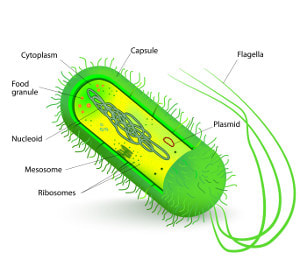
A closer look inside the first "simple" life form
Prokaryote bacteria - the first known cell, or one of many created together?
A Prokaryote (1) bacteria is considered the first single-cell animal, claimed to have been found among the oldest known rocks on Earth. However, when closely studied with electron computer imaging we find this tiny creature amazingly complex, made with many millions of molecules operating in perfect order, like the 747! "The genetic material (DNA) in most bacteria contains some 4.7 million base pairs. Stretched out, this molecule would be about 1,000 times longer than the bacterium itself".(2) The DNA is just the software, what about all the other systems that work, read, duplicate (The DNA of bacteria alone replicate error-free at an amazing rate 30,000 "letters" per minute) and assemble in the cell! In other words these tiny animals are far from "simple". They maybe said to be less complicated as their companions the Eukaryotes (mentioned later), which are far more complex in comparison. As we can see, dead chemicals becoming life are a big deal, and explaining this gap away with a few drawings and words is entirely over-simplistic. (2,3) We also must consider cell only have DNA reading capacity, not information writing capacity like your computer has. In Charles Darwins day, the general understanding of biologic change was that characteristics could be inherited--that is, if an animal acquired a physical characteristic during its lifetime, it could pass those characteristic on to its progeny. This of course was proved false years later.
1.http://hyperphysics.phy-astr.gsu.edu/hbase/biology/prokar.html
2.http://static-www.icr.org/i/articles/news/prokaryote_bacteria_wide.jpg
3.http://www.icr.org/article/tiny-bacterias-big-challenge-darwin/
Prokaryote bacteria - the first known cell, or one of many created together?
A Prokaryote (1) bacteria is considered the first single-cell animal, claimed to have been found among the oldest known rocks on Earth. However, when closely studied with electron computer imaging we find this tiny creature amazingly complex, made with many millions of molecules operating in perfect order, like the 747! "The genetic material (DNA) in most bacteria contains some 4.7 million base pairs. Stretched out, this molecule would be about 1,000 times longer than the bacterium itself".(2) The DNA is just the software, what about all the other systems that work, read, duplicate (The DNA of bacteria alone replicate error-free at an amazing rate 30,000 "letters" per minute) and assemble in the cell! In other words these tiny animals are far from "simple". They maybe said to be less complicated as their companions the Eukaryotes (mentioned later), which are far more complex in comparison. As we can see, dead chemicals becoming life are a big deal, and explaining this gap away with a few drawings and words is entirely over-simplistic. (2,3) We also must consider cell only have DNA reading capacity, not information writing capacity like your computer has. In Charles Darwins day, the general understanding of biologic change was that characteristics could be inherited--that is, if an animal acquired a physical characteristic during its lifetime, it could pass those characteristic on to its progeny. This of course was proved false years later.
1.http://hyperphysics.phy-astr.gsu.edu/hbase/biology/prokar.html
2.http://static-www.icr.org/i/articles/news/prokaryote_bacteria_wide.jpg
3.http://www.icr.org/article/tiny-bacterias-big-challenge-darwin/
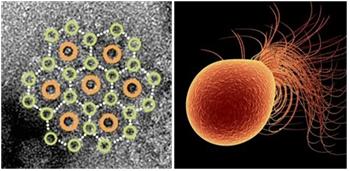
A Prokaryote single cell has a motor? Yes, one powered by protons with a free spinning center shaft!
To the left is an Electron Microscope side view image of the Prokaryote proton powered axial motor (image RH is facsimile of the creature.) Notice the rotor shaft oriented in vertical center in the left hand image. This is the spinning part that protrudes out the top of the motor that connects to the propelling tall that provides water propulsion. These so called "simple" life forms incorporate this amazingly complex device to propel them, the Axial Flagellum Proton-Powered Motor. (1) This unit has a spinning axial shaft to propel itself like a motor powered boat! Millions of dollars are being spent to understand the operation of this engine, and many questions remain about its actual operation and what controls it. Interesting thing is, a Prokaryote is thought to be a primordial cell, or first one out of the primordial "soup" in evolutionary terms. Now that technology exists to study them, the issue of complexity has become inexplicable in evolutionary terms. Researches are often at a loss for words to describe this micro-machine. Again, evolutionists are faced with describing the evolutionary origin of the motor and how it came about to be powered by protons. A few examples are quoted for further study below.
Video explaining the motor with Dr. Mike Behe, writer of Darwin's Black Box:
▶ Unlocking the Mystery of Life - Irreducible Complexity Clip - YouTube
1. http://www.uncommondescent.com/intelligent-design/the-bacterial-flagellum-truly-an-engineering-marvel/
2. http://hyperphysics.phy-astr.gsu.edu/hbase/particles/proton.html
To the left is an Electron Microscope side view image of the Prokaryote proton powered axial motor (image RH is facsimile of the creature.) Notice the rotor shaft oriented in vertical center in the left hand image. This is the spinning part that protrudes out the top of the motor that connects to the propelling tall that provides water propulsion. These so called "simple" life forms incorporate this amazingly complex device to propel them, the Axial Flagellum Proton-Powered Motor. (1) This unit has a spinning axial shaft to propel itself like a motor powered boat! Millions of dollars are being spent to understand the operation of this engine, and many questions remain about its actual operation and what controls it. Interesting thing is, a Prokaryote is thought to be a primordial cell, or first one out of the primordial "soup" in evolutionary terms. Now that technology exists to study them, the issue of complexity has become inexplicable in evolutionary terms. Researches are often at a loss for words to describe this micro-machine. Again, evolutionists are faced with describing the evolutionary origin of the motor and how it came about to be powered by protons. A few examples are quoted for further study below.
Video explaining the motor with Dr. Mike Behe, writer of Darwin's Black Box:
▶ Unlocking the Mystery of Life - Irreducible Complexity Clip - YouTube
1. http://www.uncommondescent.com/intelligent-design/the-bacterial-flagellum-truly-an-engineering-marvel/
2. http://hyperphysics.phy-astr.gsu.edu/hbase/particles/proton.html
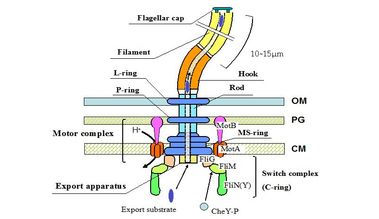 Side view of the Proton motor. over 20 integrated parts
Side view of the Proton motor. over 20 integrated parts
Diagram of the Axial Flagellum motor found in many bacteria.
This amazing machine is found in many Prokaryote bacteria (like e.coli for instance) and are described with labels such as 'rotor' and 'stator', identical to modern AC electric motors. The propelling tail or flagella has been found to be almost 100% efficient and a complex wonder in it's own right. The motor is powered using hydrogen ions (protons) and in some cases sodium.(1) Charges act on fixed 'coils' arranged in clock locations around the free spinning rotor shaft. The shaft is connected to its propeller or ‘flagella’. No one knows exactly how these motors work or even start turning, but we know that ion motive energy is metered at the proper time to control speed and direction of the 'rotor' shaft by acting on these 'coils'. AC electric motors require a "start circuit' to begin rotation, and may not change direction of rotation on the fly or stop like this motor can. (2) A complicated controller is used meter out small handfuls of ions in step measure. One paper (3) claims to have measured the normal proton feed per coil at 37, +/- 2!
The e. coli has 11 coils and turn at several hundreds of RPM. Some species turn @100,000 rpm, so equipped with 10 coils this would equal 1,000,000 proton pulses per minute! These motors also have a torque sensor and feedback loop to instruct the creature to run at differing speeds and direction like forward and backward, not bad for a 'simple' single cell! In fact, the Prokaryotes mentioned actually live inside you now, they are classed as e. coli!
Dr. Howard C. Berg of Harvard is considered a world authority in the study of these motors. In the paper cited he makes these interesting statements;
"We know a great deal about motor structure, genetics, assembly, and function, but we do not really understand how it works"...
"Thus, the flagellar motor is the output organelle of a remarkable sensory system, the components of which have been honed to perfection by billions of years of evolution. (4)
Dr. Berg's, research is outstanding and well written, but may we stop for a moment and look at your origin claims here? Lets ask two questions regarding this statement;
1. Science has not yet unraveled the mystery of this tiny isolated part of this "simple" creature, so how can one attribute such complexity to mindless, self-producing evolution? Where are examples of such change processes going on today? If the development was mindless and accidental, we with minds should be able to unravel this "marvel", or better yet, construct one of our own, but we can't.
2. This said, an age-range is suggested for this complex motor, "honed to perfection" by "Billions of years of evolution.", but no example's are provided nor cited. No examples exist in science where time has made anything operable with 3 or more interacting parts. So how is time the creator?, we know the motor has over 20 parts made of thousands and thousands of perfectly arranged proteins as instructed by the DNA.
The question must be asked, by what process did this tiny little motor develop in Billions of years? Naturalists place Prokaryotes at about 3.5 billion years old, so how can these fully formed creatures have taken "billions of years" to "hone?", the first "simple" life forms? What were the steps this multi-billion year "honing" process and where is the evidence supporting such a process? It's simple, evolutionists claim Prokaryotes are simple and as such must be primitive. These "simple" creatures have nearly the same number of parts as a 747 (about six million, but that includes the screws and rivit's!), which like the aircraft, work together perfectly. Further, these cell's do things the '47' cannot do - like multiply. And by they way, they both have motors, the MO-1 version has three more than the Boeing model! (See formation section below)
1. SO and H Structure of the Flagellar Motor Protein Complex PomAB: Implications for the Torque-Generating Conformation
2. http://www.osaka-u.ac.jp/en/news/ResearchRelease/2012/11/20121127_1
3. http://www.plosbiology.org/article/info%3Adoi%2F10.1371%2Fjournal.pbio.1000616
4. Berg, Howard C. THE ROTARY MOTOR OF BACTERIAL FLAGELLA - Annual Review of Biochemistry, 72(1):19
This amazing machine is found in many Prokaryote bacteria (like e.coli for instance) and are described with labels such as 'rotor' and 'stator', identical to modern AC electric motors. The propelling tail or flagella has been found to be almost 100% efficient and a complex wonder in it's own right. The motor is powered using hydrogen ions (protons) and in some cases sodium.(1) Charges act on fixed 'coils' arranged in clock locations around the free spinning rotor shaft. The shaft is connected to its propeller or ‘flagella’. No one knows exactly how these motors work or even start turning, but we know that ion motive energy is metered at the proper time to control speed and direction of the 'rotor' shaft by acting on these 'coils'. AC electric motors require a "start circuit' to begin rotation, and may not change direction of rotation on the fly or stop like this motor can. (2) A complicated controller is used meter out small handfuls of ions in step measure. One paper (3) claims to have measured the normal proton feed per coil at 37, +/- 2!
The e. coli has 11 coils and turn at several hundreds of RPM. Some species turn @100,000 rpm, so equipped with 10 coils this would equal 1,000,000 proton pulses per minute! These motors also have a torque sensor and feedback loop to instruct the creature to run at differing speeds and direction like forward and backward, not bad for a 'simple' single cell! In fact, the Prokaryotes mentioned actually live inside you now, they are classed as e. coli!
Dr. Howard C. Berg of Harvard is considered a world authority in the study of these motors. In the paper cited he makes these interesting statements;
"We know a great deal about motor structure, genetics, assembly, and function, but we do not really understand how it works"...
"Thus, the flagellar motor is the output organelle of a remarkable sensory system, the components of which have been honed to perfection by billions of years of evolution. (4)
Dr. Berg's, research is outstanding and well written, but may we stop for a moment and look at your origin claims here? Lets ask two questions regarding this statement;
1. Science has not yet unraveled the mystery of this tiny isolated part of this "simple" creature, so how can one attribute such complexity to mindless, self-producing evolution? Where are examples of such change processes going on today? If the development was mindless and accidental, we with minds should be able to unravel this "marvel", or better yet, construct one of our own, but we can't.
2. This said, an age-range is suggested for this complex motor, "honed to perfection" by "Billions of years of evolution.", but no example's are provided nor cited. No examples exist in science where time has made anything operable with 3 or more interacting parts. So how is time the creator?, we know the motor has over 20 parts made of thousands and thousands of perfectly arranged proteins as instructed by the DNA.
The question must be asked, by what process did this tiny little motor develop in Billions of years? Naturalists place Prokaryotes at about 3.5 billion years old, so how can these fully formed creatures have taken "billions of years" to "hone?", the first "simple" life forms? What were the steps this multi-billion year "honing" process and where is the evidence supporting such a process? It's simple, evolutionists claim Prokaryotes are simple and as such must be primitive. These "simple" creatures have nearly the same number of parts as a 747 (about six million, but that includes the screws and rivit's!), which like the aircraft, work together perfectly. Further, these cell's do things the '47' cannot do - like multiply. And by they way, they both have motors, the MO-1 version has three more than the Boeing model! (See formation section below)
1. SO and H Structure of the Flagellar Motor Protein Complex PomAB: Implications for the Torque-Generating Conformation
2. http://www.osaka-u.ac.jp/en/news/ResearchRelease/2012/11/20121127_1
3. http://www.plosbiology.org/article/info%3Adoi%2F10.1371%2Fjournal.pbio.1000616
4. Berg, Howard C. THE ROTARY MOTOR OF BACTERIAL FLAGELLA - Annual Review of Biochemistry, 72(1):19
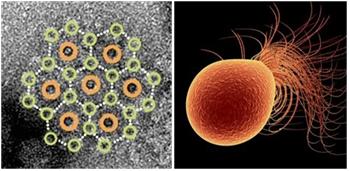
What? They found a proton powered cell with 7 motors and 24 gears!
That's correct! The MO-1, (theme picture of this page above) a 7 motor bacteria with a gearbox! (theme image of this post above). This 2012 Japanese discovery (1) baffled the microbiological world with it's uncanny complexity. Think of it, not one but seven proton synchronized motors interconnected with a planetary gearbox. The flagella propellers are inter-linked for minimum drag profile and maximum thrust using 24 gears, similar to modern aircraft and mufti-engine helicopters! See the the animation of the MO-1 planetary gear train.(2) The LH image is a rendering looking at the thrust end of the MO-1. The complex interrelated gear-set is made of hard fibers of the correct size and tooth count. Amazingly the seven flagella propellers interact without cavitation with perfect efficiency and harmony. Hardly a picture of accidents, mutations and mindlessness. (3) This creature also has other amazing capabilities like adding ions to it internal chemistry for survival and navigating using internal iron pellets. (4)
That's correct! The MO-1, (theme picture of this page above) a 7 motor bacteria with a gearbox! (theme image of this post above). This 2012 Japanese discovery (1) baffled the microbiological world with it's uncanny complexity. Think of it, not one but seven proton synchronized motors interconnected with a planetary gearbox. The flagella propellers are inter-linked for minimum drag profile and maximum thrust using 24 gears, similar to modern aircraft and mufti-engine helicopters! See the the animation of the MO-1 planetary gear train.(2) The LH image is a rendering looking at the thrust end of the MO-1. The complex interrelated gear-set is made of hard fibers of the correct size and tooth count. Amazingly the seven flagella propellers interact without cavitation with perfect efficiency and harmony. Hardly a picture of accidents, mutations and mindlessness. (3) This creature also has other amazing capabilities like adding ions to it internal chemistry for survival and navigating using internal iron pellets. (4)
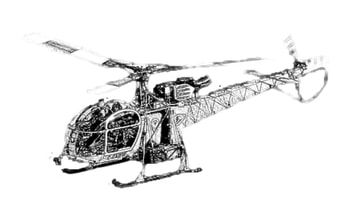
This SA315B Lama helicopter has 12 planetary gears, designed with utmost care to a perfect fit. Interesting how evolution could make 24 by accident's, each fit with tighter tolerances than this machine! Evolutionists claim to be open-minded and willing to modify their theory as new discoveries emerge. What will they do with the MO-1? The US peer review board has already declared MO-1 of evolutionary origin.
As a pilot and technician that had his life depend on good equipment like the Lama, I would never let anything go to "chance". For more about my adventures in these and other aircraft in Alaska, see my up coming book - "Last of the Long Hunters". Every machine like this comes with a set of manuals. People have a manual for life also. Its called the Bible. See the about section for more on that topic..
1. MO-1 Japanese article
2. http://www.pnas.org/content/suppl/2012/11/22/1215274109.DCSupplemental/sm01.mov
3. Germ 7 motors in 1 The MO-1 Discovery (link to Creation.com)
4. Bacteria That Synthesize Nano-sized Compasses to Navigate Using Earth's Geomagnetic Field | Learn Science at Scitable
Image thanks to PNAS, Juanfang Ruan, 20643–20648 http://www.pnas.org/content/109/50/20643/F6.expansion.html
As a pilot and technician that had his life depend on good equipment like the Lama, I would never let anything go to "chance". For more about my adventures in these and other aircraft in Alaska, see my up coming book - "Last of the Long Hunters". Every machine like this comes with a set of manuals. People have a manual for life also. Its called the Bible. See the about section for more on that topic..
1. MO-1 Japanese article
2. http://www.pnas.org/content/suppl/2012/11/22/1215274109.DCSupplemental/sm01.mov
3. Germ 7 motors in 1 The MO-1 Discovery (link to Creation.com)
4. Bacteria That Synthesize Nano-sized Compasses to Navigate Using Earth's Geomagnetic Field | Learn Science at Scitable
Image thanks to PNAS, Juanfang Ruan, 20643–20648 http://www.pnas.org/content/109/50/20643/F6.expansion.html
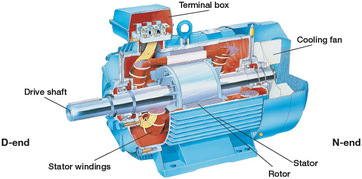 Both this unit and the Prokaryotes use electric fields to turn
Both this unit and the Prokaryotes use electric fields to turn
Modern AC motor showing rotor and stator assemblies - "Intelligence acting on Matter"
The Axial Proton Motor arrangement is almost identical to modern AC (alternating current) brushless motors first invented by Nicolai Tesla (1) that changed the world. They said it couldn't be done! Think of it, a proton powered unit with no wires, bearings or metal, and 1/200,000 smaller than mans best device, (2) 'invented' long before Tesla made his! Amazingly, the Prokaryote motor can drive this little creature @ relative speeds of 50 BL (body lengths)/second and in the MO-1 100 B/L/Sec.! A Cheetah achieves a land speed of only 25BL/Sec.in comparison and that's in air, not fluid!
We know the research suggests these Prokaryotes use electromagnetic forces to operate, as use of a magnet will stop their motor from turning! (3)
1. http://www.teslasociety.com/hall_of_fame.htm
2. IEEE Xplore - Flagella-like Propulsion for Microrobots Using a Nanocoil and a Rotating Electromagnetic Field
3. magnet stalled Load-Dependent Assembly of the Bacterial Flagellar Motor
A Test of Evolution theory you can do -
Motor Kit Project
So here is a simple test of Evolution Vs Intelligent Design you can do yourself;
Purchase a battery powered motor kit ready to assemble. Read the instructions, wind the rotors, setup the whisker brushes, assemble the armature and commutator, add a battery and if completed correctly, the motor will spin. If so, Congratulations! you have applied intelligence to matter and created something that works with 3 or more parts - Intelligent Design proven.
The Axial Proton Motor arrangement is almost identical to modern AC (alternating current) brushless motors first invented by Nicolai Tesla (1) that changed the world. They said it couldn't be done! Think of it, a proton powered unit with no wires, bearings or metal, and 1/200,000 smaller than mans best device, (2) 'invented' long before Tesla made his! Amazingly, the Prokaryote motor can drive this little creature @ relative speeds of 50 BL (body lengths)/second and in the MO-1 100 B/L/Sec.! A Cheetah achieves a land speed of only 25BL/Sec.in comparison and that's in air, not fluid!
We know the research suggests these Prokaryotes use electromagnetic forces to operate, as use of a magnet will stop their motor from turning! (3)
1. http://www.teslasociety.com/hall_of_fame.htm
2. IEEE Xplore - Flagella-like Propulsion for Microrobots Using a Nanocoil and a Rotating Electromagnetic Field
3. magnet stalled Load-Dependent Assembly of the Bacterial Flagellar Motor
A Test of Evolution theory you can do -
Motor Kit Project
So here is a simple test of Evolution Vs Intelligent Design you can do yourself;
Purchase a battery powered motor kit ready to assemble. Read the instructions, wind the rotors, setup the whisker brushes, assemble the armature and commutator, add a battery and if completed correctly, the motor will spin. If so, Congratulations! you have applied intelligence to matter and created something that works with 3 or more parts - Intelligent Design proven.
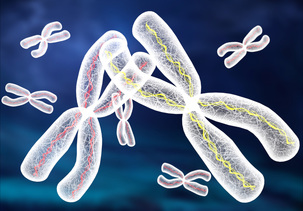 Chomosomes take sections of DNA and compact them1000X
Chomosomes take sections of DNA and compact them1000X
"This condensation is needed to allow the chromosomes to move along the mitotic spindle without becoming tangled or broken during their distribution to daughter cells....Despite its fundamental importance, the mechanism of chromosome condensation during mitosis is not understood". 2 The
"aster" cords then reach out and connect to the gene
"centomere's" (center at the X point), and pull them apart in perfect
pairs as by some unseen hand (see above diagram, note the
row of red/green
X's in the center image). Once in their
corners the cell begins the process of physical division. After this stage, the segments magically
de-compress back into a looping string and reform the nucleus! So thats the end of the matter, a completely different cycle entirely unrelated.
If any part of their ancestral (consumption) explanations were true, why aren't we seeing any of these change processes going on today? With that train of thought, eating chicken should allow one to fly!. I'll make an assertion, the Grand Designer himself created these two entirely independent processes to show evolutionary explanations in error. Eukaryotes are highly complex and independently designed marvel's. When one understands the ability of the Creator, we all benefit with better science and "the wisdom from above" promotes good thinking as well. (1)
1. CELL DIVISION: BINARY FISSION AND MITOSIS
2. Cooper GM. The Cell: A Molecular Approach. 2nd edition. Sunderland (MA): Sinauer Associates; 2000. Figure 14.32, Comparison of meiosis and mitosis. Available from: http://www.ncbi.nlm.nih.gov/books/NBK9901/figure/A2486/
Video; Prokaryote Cell "Binary Fission" reproduction
Asexual Reproduction - YouTube
Video;Eukaryote Cell "Mitosis" reproduction
▶ Mitosis Egg - YouTube
Statement of a micro-biologist who refuse's to support Evolution;
A world-famous chemist tells the truth: there’s no scientist alive today who understands macroevolution | Uncommon Descent
Here are more that feel the same;
DarwinAd4.qxd - 100ScientistsAd.pdf
We hope after considering the information given you are encouraged to consider the possibility of a Creator. Even though evolutionary thought prevails our society, the other side of the Origin story clearly points to Intelligence, an Intelligence you may know through Jesus Christ, the Author of all life. God sees you reading these lines now and desires you to have a fuller knowledge of Him and His provision made in your behalf. God enjoys your marveling and searching out His works, He further enjoys you understanding Him! God Bless you with His truth!
If any part of their ancestral (consumption) explanations were true, why aren't we seeing any of these change processes going on today? With that train of thought, eating chicken should allow one to fly!. I'll make an assertion, the Grand Designer himself created these two entirely independent processes to show evolutionary explanations in error. Eukaryotes are highly complex and independently designed marvel's. When one understands the ability of the Creator, we all benefit with better science and "the wisdom from above" promotes good thinking as well. (1)
1. CELL DIVISION: BINARY FISSION AND MITOSIS
2. Cooper GM. The Cell: A Molecular Approach. 2nd edition. Sunderland (MA): Sinauer Associates; 2000. Figure 14.32, Comparison of meiosis and mitosis. Available from: http://www.ncbi.nlm.nih.gov/books/NBK9901/figure/A2486/
Video; Prokaryote Cell "Binary Fission" reproduction
Asexual Reproduction - YouTube
Video;Eukaryote Cell "Mitosis" reproduction
▶ Mitosis Egg - YouTube
Statement of a micro-biologist who refuse's to support Evolution;
A world-famous chemist tells the truth: there’s no scientist alive today who understands macroevolution | Uncommon Descent
Here are more that feel the same;
DarwinAd4.qxd - 100ScientistsAd.pdf
We hope after considering the information given you are encouraged to consider the possibility of a Creator. Even though evolutionary thought prevails our society, the other side of the Origin story clearly points to Intelligence, an Intelligence you may know through Jesus Christ, the Author of all life. God sees you reading these lines now and desires you to have a fuller knowledge of Him and His provision made in your behalf. God enjoys your marveling and searching out His works, He further enjoys you understanding Him! God Bless you with His truth!